As we recently learned during our trip, the delights of Turkey are many. The friendly people, the incredibly delicious food, the surprisingly enjoyable wine, and mainly, the history/architectural wonders/amazing sense of cultural presence. All of these could be the subject of numerous posts (and hopefully I can get to a post on the incredible tilework in the near future). But I came back from Turkey really inspired by the variety of beautiful textile arts.


Carpet weaving tends to be the main textile associated with Turkey and other areas of Central Asia. The carpets to the left and the right are beautiful examples from the Topkapi Palace, home of the sultans for centuries. Indeed, even before we arrived, I had carpet lust and resolved to at least try and acquire my own piece of amazing color and craftmanship. Seeing these works of art and the hundreds of beautiful carpets hanging in the many, many, many stores of Istanbul only strengthened that resolve. However, as we had another 1.5 weeks of travel before we returned to Istanbul, I did not even step foot into a carpet shop during those first few days. What a great plan (even if not intentional) because it freed up my focus to explore other textiles.
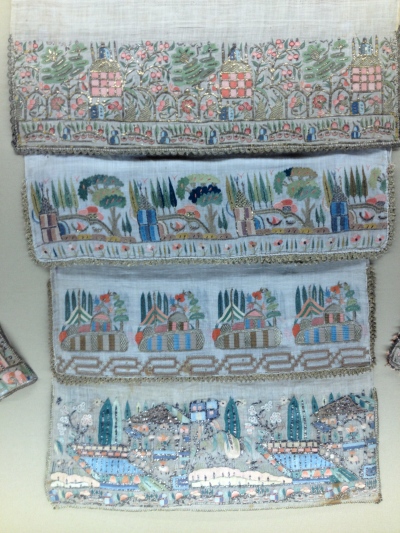
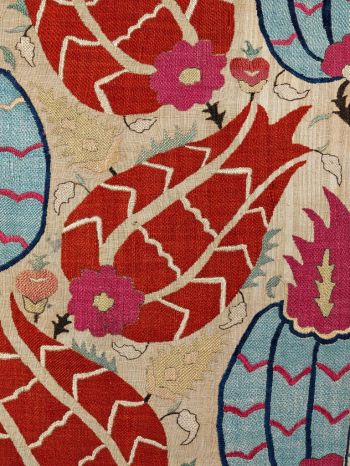 Amazing Ottoman embroidery delights awaited me at the Sadberk Hanim museum near Sariyer, up the Bosphorus from Istanbul. (It is well worth the visit even if you’re not into textiles – they have an incredibly impressive archaeological collection, dating back to 6,000 B.C., as well as a very impressive Turkish-Islamic collection with some fantastic tile and ceramic work). The not-so-great picture on the left (taken surreptitiously when the guard wasn’t looking) shows some wonderful examples of embroidered borders. Unfortunately, the detail just can’t be seen at this photo scale. The photo on the right is taken from the museum’s website and provides a much better detail on the stitch definition, colors, and the linen plainweave in the background. The exhibit was breathtakingly wonderful – I’m sorry I couldn’t get more pictures to share. There were many diaromas of 18th century rooms demonstrating exactly how different embroidered cloths would have been used in the household. The elaborateness of the daily ritual was astounding – coffee service trays would get their own richly-embroidered cover that was held around the tray like a skirt when serving coffee. One other interesting thing we learned is that since a girl (and her household) would spend much time embroidering items for her trousseau, it was customary to have a party before the wedding where all the finely-embroidered items were shown off to guests, so they could admire the work.
Amazing Ottoman embroidery delights awaited me at the Sadberk Hanim museum near Sariyer, up the Bosphorus from Istanbul. (It is well worth the visit even if you’re not into textiles – they have an incredibly impressive archaeological collection, dating back to 6,000 B.C., as well as a very impressive Turkish-Islamic collection with some fantastic tile and ceramic work). The not-so-great picture on the left (taken surreptitiously when the guard wasn’t looking) shows some wonderful examples of embroidered borders. Unfortunately, the detail just can’t be seen at this photo scale. The photo on the right is taken from the museum’s website and provides a much better detail on the stitch definition, colors, and the linen plainweave in the background. The exhibit was breathtakingly wonderful – I’m sorry I couldn’t get more pictures to share. There were many diaromas of 18th century rooms demonstrating exactly how different embroidered cloths would have been used in the household. The elaborateness of the daily ritual was astounding – coffee service trays would get their own richly-embroidered cover that was held around the tray like a skirt when serving coffee. One other interesting thing we learned is that since a girl (and her household) would spend much time embroidering items for her trousseau, it was customary to have a party before the wedding where all the finely-embroidered items were shown off to guests, so they could admire the work.
After leaving Istanbul and discovering the fascinating Greek and Roman ruins around Miletus, Priene, and Ephesus, we made a different type of textile discovery in Sirince, a hilltop town above Selcuk/Ephesus known for its historic Greek population and fruit wines. The wine house/historic school in the center of town had a “museum” and a shop selling felted items, the brainchild of a young man who billed himself “The Last of the Great Felt Warriors.” There was a (very) small exhibit of some historic felt rugs, tents, and saddlecloths, with some explanation of their uses and the all natural plant dyes used to make these items. The shop items included wall hangings, small rugs, and other felt items with traditional folk motifs. All the dyes are natural and the entire felting process is done by hand, starting with about 4 feet of felt to shrink down to 1-2″ for a rug. After much deliberation, I selected the following 2 x 3 little rug for our own. 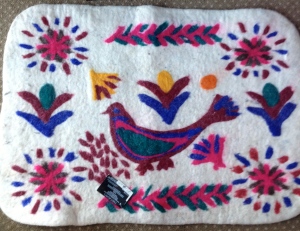
Of course, this did not satisfy my need for a “carpet” (wholly justifiable because they are two entirely different techniques, right?!) Upon our return to Istanbul, I went to the Troy Rug Store in the Arasta Bazaar, after reading several favorable reviews from people who really enjoyed dealing with Mustafa Cesur. I also had a wonderful experience – Mustafa is genuine, honest, and not a big haggler. Even though I started out looking for a big name region I’d heard of, after looking through many rugs, my eye and heart ended up with a 50-60 year old Kurdish carpet, for the patina, the subtlety, and the richness of color. After we completed that purchase, Mustafa spent another 20 minutes with me, showing me different kilims, grain bags, and saddle bags. All beautiful. But alas, I’d spent enough for one trip and will have to save such purchases for when I return to Turkey, for return I shall. But for now, here is our little bit of Turkey at home.
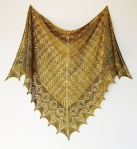
 To that end, I’m knitting a lace triangular shawl in a yarn that could double for Indian corn (this photo doesn’t do justice to the play of colors). It’s Madelinetosh Tosh Merino Light, in colorway “Stephen Loves Tosh” (named, I believe, for knit designer Stephen West). The pattern is the Alexandra shawl by Dee O’Keefe. The pattern is extremely well-written and I quickly found I had nothing to fear from the multiple charts and diagrams. Shawl construction means that the pattern is always adjusting to the growing size (it’s knit from the top center out). In my opinion, this makes it much more interesting than a lace blanket or scarf which simply repeats ad nauseum. I wasn’t sure that I’d actually wear a “shawl” but I plan to treat it just like a big scarf. I hope it’s actually done during the fall!
To that end, I’m knitting a lace triangular shawl in a yarn that could double for Indian corn (this photo doesn’t do justice to the play of colors). It’s Madelinetosh Tosh Merino Light, in colorway “Stephen Loves Tosh” (named, I believe, for knit designer Stephen West). The pattern is the Alexandra shawl by Dee O’Keefe. The pattern is extremely well-written and I quickly found I had nothing to fear from the multiple charts and diagrams. Shawl construction means that the pattern is always adjusting to the growing size (it’s knit from the top center out). In my opinion, this makes it much more interesting than a lace blanket or scarf which simply repeats ad nauseum. I wasn’t sure that I’d actually wear a “shawl” but I plan to treat it just like a big scarf. I hope it’s actually done during the fall! I finally checked out the library’s copy of A Time of Gifts, his legendary account of his walk across Europe to Constantinople (well, the first part of the journey, anyway). Although only an introduction and 25 pages in, I think I’m really going to enjoy it. The writing is very lucid, firmly based in a classical education the likes of which exist no more, and full of interesting asides. I understand that the long-awaited conclusion to the trilogy will be released this fall, taken from Leigh Fermor’s earlier notes for the project. Having just been to Istanbul, I’ll be delighted to read an account of how it was in the 1930s, but for now, I’m back in Holland, slowly exploring the canal paths in the snow.
I finally checked out the library’s copy of A Time of Gifts, his legendary account of his walk across Europe to Constantinople (well, the first part of the journey, anyway). Although only an introduction and 25 pages in, I think I’m really going to enjoy it. The writing is very lucid, firmly based in a classical education the likes of which exist no more, and full of interesting asides. I understand that the long-awaited conclusion to the trilogy will be released this fall, taken from Leigh Fermor’s earlier notes for the project. Having just been to Istanbul, I’ll be delighted to read an account of how it was in the 1930s, but for now, I’m back in Holland, slowly exploring the canal paths in the snow.






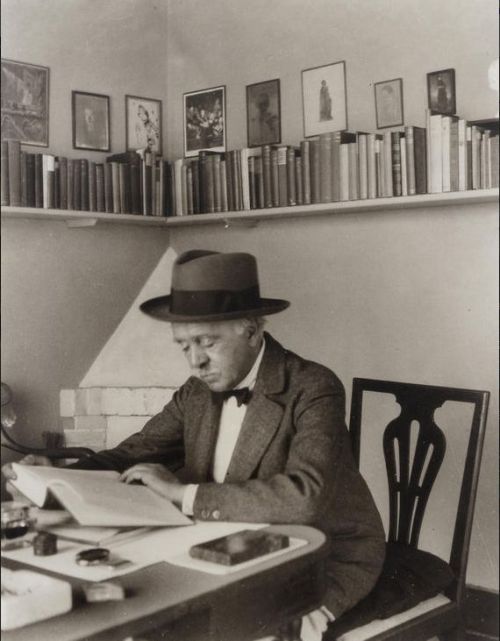






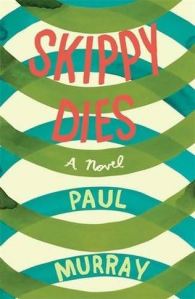 One of those is
One of those is